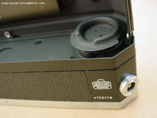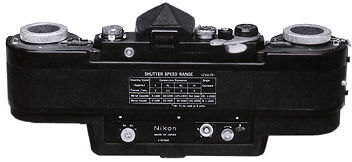|
Modern Classic SLRs Series :
Nikon F - F250
Motor Drive
|
| |
 |

|
F36 cordless &
F250 Motor Drive for Nikon F
(View
shown here are the two cordless MD available for the Nikon F)
F36 with
Cordless battery pack
Provides automatic fire power in its most convenient form. Attaches directly
to the F36 motor drive and transforms the Nikon F into an integrated, one-piece automatic
unit. Has built-in release button and selector switch for single and sequence shots.
Built-in relay simplifies remote operation.
|
 |
Uses conventional
2-conductor, household-type cord, which may be connected to a manual switch, intervalometer,
radio control receiver or other switching device.
The cordless battery pack is designed for use with the F36 motor drive only. It holds
8 penlite AA batteries. It may also be operated from an external 12-volt DC source.
It is not necessary to detach the cordless pack while changing films.
|
Photo Showcase on few old /new versions of the Nikon F36 Motor Drive
Units
|
|
Nikon F250 Motor Drive
The Nikon
F250 motor drive extends Nikon automatic fire power to applications where frequent
film changes are impratical.
 |
Using special cassettes
which hold up to 33 feet of bulk film, it delivers 250 exposures without the need
to do reloading. It can also be used with standard 20 and 36 exposure loads.
Nikon F250
Motor Drive The F250 motor drive extends Nikon automatic fire power to applications
where frequent film changes are impratical. Using special cassettes which hold up
to 33 feet of bulk film, it delivers 250 exposures without the need to do reloading.
It can also be used with standard 20 and 36 exposure loads.
|
Photo Showcase on Nikon
F250
|
Credit: Image courtesy of Mr. Peter Coeln from LEICA Shop®, Austria who also operates a popular Westlicht Auction House. Image Copyright © 2008. All rights
reserved. Please respect the visual property of the contributing photographer.
|
The F250 provides
the same selection of firing rates and shutter speeds as the F36. It operates with
the standard Nikon battery Pack. The
overall specifications and the operation of the three back dials of the F250 are
the same as those for the F36,
listed on the previous page.
Obviously, the F250 uses its own special cassettes, can only be used with the Cord
Pack, and has its own set of loading and attaching procedures. In a frontal view
of the F250 (i.e. with the three knobs facing away from you), note that the film
chamber on the same side as the power connector is smaller than the other side; the
smaller side will be referred to as the supply-side, and the larger side will be
the take-up-side (please, no cheesy economics jokes).
-
Bulk Film Loader
with 250 exposure film cassettes.
Unlike the F36, the F250 does not have the keyed lock/unlock on its bottom plate.
It actually attaches over the strap eyelets.
 |
The top of the F250 is dominated
by two large, knurled knobs at either end; there is one slider just inboard of each
knob, which goes over the strap eyelets. The very right edge (i.e. the take-up side)
of the F250 also has a back-plate lock on it. To fit the F250 to the F, assuming
camera and motor are synchronised:
|
- turn both knurled
knobs so that "open" lines up with the white index dot towards the back
of the camera (i.e. turn the supply-side knob clockwise, and the take-up-side knob
counter-clockwise)
- slide each slider
outwards, uncovering the grooves into which the camera's eyelets will go
- fit the camera
(without standard back) to the motor and back
- slide the sliders
back inwards, locking the camera's eyelets in place
- raise the back-plate
lock on the take-up-side chamber and remove the back-plate
-
Now you are ready
to load the MZ-1 cassette with 33 feet (10m) of film. On the other hand, you can
use your camera as a massive F36 -- you need to remove the camera (reverse steps
3-4 above and load the cassette [can't use Nikon's reloadable cassette] normally)
and then fit the camera to the F250 again. For those of you with MZ-1's, this is
how you load one:
- open the cassette:
- press the silver
button under the "J" in "Japan"
- rotate the shell
relative to the top plate until the openings in the two halves line up
- separate the two
halves
- go into the darkroom
- trim leader of
bulk film to form a "tongue" appox. 30mm long and 20mm wide (1.2 in. long
and 0.8 in. wide)
- put the tongue
into one of the two slots on the spool inside the MZ-1
- wind about 10m
(33ft) onto the spool, with the emulsion side on the inside (using the winder, if
available):
- put the bulk-film
supply on the film drum spindle, with the film coming over the axis, not under.
- put the MZ-1's
spindle on the winding spool
- trim leader, if
necessary, and thread film into the MZ-1's spindle, taking care to pass over the
sprockets and passing film over the axis of the MZ-1's spindle
- swing the film
pressure lever over the film
- pull and turn
the exposure-frame dial to set the total number of frames to be wound
- wind (at appox.
2-3 frames/sec) until you reach the preset, which will cause the winding to stop
- cut the film approximately
halfway between spools
- place loaded spool
into "top half" of MZ-1 with film protruding (to the right, if "top
half" is held so that "Nikon" and "Japan" are facing up)
- close the cassette:
- slide "bottom
half" over "top half"
- turn "top
half" clockwise until you hear two clicks, meaning that the catch has fallen
into place
- leave the darkroom
-
Hey, we're not
through the woods, yet. You still need to put the loaded cassette into the supply
chamber, which requires a bit of care:
- pull out the supply-knob
(on the bottom of the chamber)
- align the small
tab on the cassette with the corresponding notch in the chamber
- align the two
silver buttons with the recess at the chamber's top
- align the white
(or red) dot near the base of the cassette with the corresponding white line on the
chamber's floor
-
Now that all that's
been done, you have to pull out some film (about 400mm or 16 in.) from the supply
spool, cut the leader to shape, and thread it onto the take-up cassette as outlined
above. Again, note that the emulsion side should be in. After sliding the take-up
cassette back into the F250, as outlined above, take up any slack in the film with
the supply-knob. Make sure that the sprocket teeth of the camera engage appropriate
holes on the film. Whew! I'll tell you this much: I don't think that the whole business
of bulk-loading film and fiddling with the MZ-1's has much changed, even today with the Nikon
F5. Finally,
replace the back plate and turn the two top knurled knobs to "close" (which
locks the eyelet holders in place and somewhat perversely opens both MZ-1's.
-
You may confirm
that the camera and motor are winding the film correctly by making sure that the
supply knob is turning as you expose film. Because you lose so much film to being
the leader, you need to make five complete "blank" exposures before getting
to the unexposed portion of the film. Similarly, when taking the completed 10m roll
out, you will need to make five "blank" exposures before removing the back.

-

Enlarged view of the control panel from the back of the F250.
Nikon made plenty
of exciting accessories for the F250, but the one that you really need is the Cord
Pack (or the MA-1) to supply power. It attaches just the same as to the F36, through
the coaxial connector on the motor's front. Strangely enough, F250's are often cheaper
than F36's, probably because of their limited usefulness to modern users (much easier
to perform time-lapse photography with an integrated intervalometer, autoexposure,
and autofocus -- ergo the F4/MF-24) and amazing bulkiness. On the other hand, you
might be able to accomplish reportage more efficiently by not having to stop and
reload so often, although the F250 only holds the equivalent of seven rolls of regular
film, and whatever you save in not reloading so often, you probably lose again in
weight/bulk, handling, loss of portability, inefficient reloading, and unwieldy processing.
So perhaps the F250 is best for the budding F collector who wants to obtain a reasonably
rare item at a decent price.
| Back | to
Index Page - Motor Drives
|
Next | Battery
Packs and Accessories
Main Reference map in HTML
& PDF:
Body
with FTN Finder
| FTN finder | camera body |
| Back | to Nikon-F - Main Index Page
Other
Nikon F Variations
The
Eyes of Nikon:-
Nippon Kogaku KK Rangefinder
RF-Nikkor
lenses:-
Main Index Page
Nikon
Auto
Focus
Nikkor lenses:- Main Index Page
Nikon
Manual
Focus
Nikkor lenses- Main Index Page
Fisheye-Nikkor Lenses - Circular | Full Frame |
Ultrawides Lenses - 13mm15mm18mm20mm | Wideangle Lenses - 24mm28mm35mm |
Standard Lenses - 45mm 50mm 58mm | Telephoto
Lenses - 85mm105mm135mm180mm & 200mm |
Super-Telephoto
Lenses - 300mm 400mm 500mm 600mm 800mm 1200mm |
Special
Application lenses:
Micro-Nikkor Lenses - 50mm~55mm -60mm 85mm -105mm 200mm Micro-Zoom 70-180mm
Perspective Control (PC) - 28mm 35mm PC-Micro 85mm
Dedicated
Lenses for Nikon F3AF: AF 80mm f/2.8 | AF 200mm f/3.5 EDIF
Depth
of Field Control (DC): 105mm 135mm
Medical
Nikkor: 120mm 200mm
Reflex-Nikkor Lenses - 500mm 1000mm 2000mm
Others:
Noct Nikkor |
OP-Nikkor | UV Nikkor 55mm 105mm |
Focusing Units | Bellows-Nikkor 105mm 135mm
Nikon
Series E Lenses: 28mm35mm50mm100mm135mm |
E-Series Zoom lenses: 36~72mm75~150mm70~210mm
MF Zoom-Nikkor Lenses: 25~50mm | 28~45mm | 28~50mm | 28~85mm | 35~70mm | 36~72mm E | 35~85mm | 35~105mm | 35~135mm |
35~200mm | 43~86mm | 50~135mm | 50~300mm | 70~210mm E | 75~150mm E | 80~200mm | 85~250mm |
100~300mm | 180~600mm | 200~400mm | 200~600mm | 360~1200mm | 1200~1700mm
Tele-Converters: TC-1 | TC-2 | TC-200 | TC-201 | TC-300 | TC-301 | TC-14 | TC-14A | TC-14B | TC-14C | TC-14E | TC-16 | TC-16A | TC-20E

Nikon F
| Nikon F2 |
Nikon
F3
| Nikon F4 |
Nikon
F5
| Nikon F6 |
Nikkormat / Nikomat |
Nikon FM
| Nikon FE/ FA | Nikon EM/FG/FG20 | Nikon Digital SLRs | Nikon - Other models
MIR Supports for Photographic Community: Various Message Boards/Community
Forums
Nikon
F-series|
Nikon
F2-series|
Nikon
F3-series|
Nikon F4-series| Nikon
F5-series|Nikkormat/Nikomat-series
Nikon FM-series|Nikon
FE-series|Nikon
FA|Nikon
Digital
SLR
series|Various
Nikon
Models|Nikkor
Optic
-shared
Others:- Free Trade Zone - Photography| Free Trade Zone - Business Community |Free To Zouk - Photographic Community
Apple's Mac Public Community Message Board | Windows based PC &
Apple/Mac
Public Community Trade Exchange Centre
Recommended links to understand
more technical details related to the Nikkor F-mount and production Serial Number:
http://rick_oleson.tripod.com/index-153.html by: my friend, Rick Oleson
http://www.zi.ku.dk/personal/lhhansen/photo/fmount.htm by: Hansen, Lars Holst
http://www.mir.com.my/rb/photography/hardwares/nikonfmount/lens2.htm
http://www.photosynthesis.co.nz/nikon/serialno.html
About
this photographic
site.
Home - Photography
In Malaysia

Copyright
© 1998. leofoo ®. MIR Web Development Team.
[Left Brain][Right brain][Home-MIR]
[Invention][Art & Design][Clubs]
[Portfolios][On assignments]
[Trading
room][Knowledge
& Resources]
[Free-trade-zone][Thoughts & opinions][Links]






